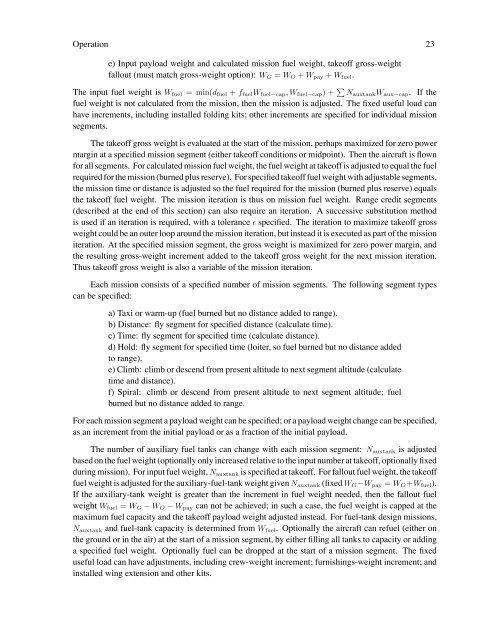Download - NASA
Download - NASA
Download - NASA
Create successful ePaper yourself
Turn your PDF publications into a flip-book with our unique Google optimized e-Paper software.
Operation 23<br />
e) Input payload weight and calculated mission fuel weight, takeoff gross-weight<br />
fallout (must match gross-weight option): WG = WO + Wpay + Wfuel.<br />
The input fuel weight is Wfuel = min(dfuel + ffuelWfuel−cap,Wfuel−cap) + NauxtankWaux−cap. If the<br />
fuel weight is not calculated from the mission, then the mission is adjusted. The fixed useful load can<br />
have increments, including installed folding kits; other increments are specified for individual mission<br />
segments.<br />
The takeoff gross weight is evaluated at the start of the mission, perhaps maximized for zero power<br />
margin at a specified mission segment (either takeoff conditions or midpoint). Then the aircraft is flown<br />
for all segments. For calculated mission fuel weight, the fuel weight at takeoff is adjusted to equal the fuel<br />
required for the mission (burned plus reserve). For specified takeoff fuel weight with adjustable segments,<br />
the mission time or distance is adjusted so the fuel required for the mission (burned plus reserve) equals<br />
the takeoff fuel weight. The mission iteration is thus on mission fuel weight. Range credit segments<br />
(described at the end of this section) can also require an iteration. A successive substitution method<br />
is used if an iteration is required, with a tolerance ɛ specified. The iteration to maximize takeoff gross<br />
weight could be an outer loop around the mission iteration, but instead it is executed as part of the mission<br />
iteration. At the specified mission segment, the gross weight is maximized for zero power margin, and<br />
the resulting gross-weight increment added to the takeoff gross weight for the next mission iteration.<br />
Thus takeoff gross weight is also a variable of the mission iteration.<br />
Each mission consists of a specified number of mission segments. The following segment types<br />
can be specified:<br />
a) Taxi or warm-up (fuel burned but no distance added to range).<br />
b) Distance: fly segment for specified distance (calculate time).<br />
c) Time: fly segment for specified time (calculate distance).<br />
d) Hold: fly segment for specified time (loiter, so fuel burned but no distance added<br />
to range).<br />
e) Climb: climb or descend from present altitude to next segment altitude (calculate<br />
time and distance).<br />
f) Spiral: climb or descend from present altitude to next segment altitude; fuel<br />
burned but no distance added to range.<br />
For each mission segment a payload weight can be specified; or a payload weight change can be specified,<br />
as an increment from the initial payload or as a fraction of the initial payload.<br />
The number of auxiliary fuel tanks can change with each mission segment: Nauxtank is adjusted<br />
based on the fuel weight (optionally only increased relative to the input number at takeoff, optionally fixed<br />
during mission). For input fuel weight, Nauxtank is specified at takeoff. For fallout fuel weight, the takeoff<br />
fuel weight is adjusted for the auxiliary-fuel-tank weight given Nauxtank (fixed WG−Wpay = WO +Wfuel).<br />
If the auxiliary-tank weight is greater than the increment in fuel weight needed, then the fallout fuel<br />
weight Wfuel = WG − WO − Wpay can not be achieved; in such a case, the fuel weight is capped at the<br />
maximum fuel capacity and the takeoff payload weight adjusted instead. For fuel-tank design missions,<br />
Nauxtank and fuel-tank capacity is determined from Wfuel. Optionally the aircraft can refuel (either on<br />
the ground or in the air) at the start of a mission segment, by either filling all tanks to capacity or adding<br />
a specified fuel weight. Optionally fuel can be dropped at the start of a mission segment. The fixed<br />
useful load can have adjustments, including crew-weight increment; furnishings-weight increment; and<br />
installed wing extension and other kits.
















